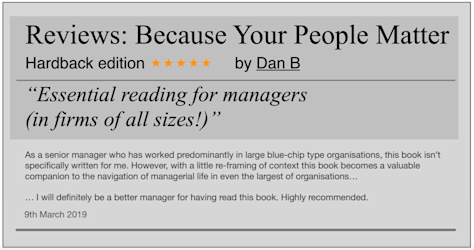One of twelve chapters of our book, Because Your People Matter: a playbook for managers, entrepreneurs, and leaders, serialised here.
Setting Objectives: the mechanism by which employees achieve outcomes
Written by John Berry & Sue Berry on 31st January 2023.0
4 min read
Chapter 6: Setting Objectives
Chapter Summary
 The idea behind objective setting and performance appraisal is simple enough, but the complexity comes in doing it. It’s a narrow arête that defines success. And the ‘drops’ either side of the metaphorical ridge are steep – it’s easy for managers to fall at various points along the way.
The idea behind objective setting and performance appraisal is simple enough, but the complexity comes in doing it. It’s a narrow arête that defines success. And the ‘drops’ either side of the metaphorical ridge are steep – it’s easy for managers to fall at various points along the way.
High-level objectives
At the outset, managers will set high level objectives for the performance of the firm. Conceivably, if the manager doesn’t ripple these objectives down to the employees, the high-level objectives won’t be met. We illustrate how a firm aiming to turn over £2.5m might develop objectives for its staff.
This idea of rippling down objectives from the central corporate objectives has merit. But even with a high degree of objectivity and linking to the firm’s fortunes, it’s still difficult to set measurable objectives for all. We use the example of a waiter to discuss why this is. Ultimately managers need to set objectives in the tangible business metrics of performance, productivity, quality (and the minimising of wastage) and safety.
We illustrate how the accountabilities in an employee’s job description should link to their objectives – the objectives make the job description accountabilities specific and current. This illustrates the key importance of a well-crafted job description setting out at a high level what the jobholder is to achieve.
Performance management
Ultimately, we argue that objectives have a key role in making performance management central in launching initiatives. Initiatives and their associated objectives give managers reason to intervene day to day in the business lives of their people. Intervention enables leadership and ensures success in those initiatives. Management will fail without accountabilities, objectives, and initiatives.
Some academics argue that setting objectives stifles creativity and there is truth in this. Narrow objectives can be set where the desired outcomes are specific. But broad outcomes, like ‘ensuring success’, might be used in complex business scenarios with unclear end goals. Objectives for research scientists will look very different from those of a project engineer; the latter will likely be broad, whereas the former will concentrate on delivering contracted outcomes.
Not just 'white collar'
We don’t subscribe, though, to the idea that objective setting is only useful for ‘white collar’ employees. We argue that it’s wrong for professional and managerial types to have a monopoly on sitting with their manager to discuss performance. We argue that all the performance of all employees can benefit from goal theory.
In search of the practical, we advocate the use of a balanced scorecard to entice managers to spread attention across the four aspects of management: finance, process, customers, and employees. In the end, financial goals will be achieved by action in the other three quadrants.
Performance is a complex metric. We believe that splitting it into task performance and contextual performance helps understanding and the setting of meaningful and objective goals. Splitting also helps identify where personal development may be needed for goal satisfaction – many employees fail to master the softer skills of contextual multi-dimensional, multi-rater systemsperformance and in that case, it’s there where managers often must focus.
Performance appraisal
Turning to performance appraisal, we look at the various ways that appraisal might be done. We evaluate the use of multi-dimensional, multi-rater systems and highlight some of the issues and the dangers. In appraisal, it’s very easy to catastrophically damage trust and the psychological contract, and hence who is invited to offer a rating on an employee should be decided with care.
 Then, we look at the skills needed by managers in objective setting and performance appraisal and draw on Boyatzis’ 23 manager competencies. We argue that the manager must be multi-competent. They must be prepared to train for management and that will naturally cover the essential skills and knowledge of objective setting and performance appraisal.
Then, we look at the skills needed by managers in objective setting and performance appraisal and draw on Boyatzis’ 23 manager competencies. We argue that the manager must be multi-competent. They must be prepared to train for management and that will naturally cover the essential skills and knowledge of objective setting and performance appraisal.
The paperwork
We describe a paperwork trail and a timescale for the process of the appraisal ‘round’, suggesting that objective setting and performance might be run on a six-monthly cycle with interim review meetings every few weeks.
Finally, we discuss the detail of the objective setting and appraisal meetings. We highlight the critical question – how is it that the manager wants their employee to leave the meeting. And we suggest the dos and don’ts to help the manager stay on the ridge, with trust intact.